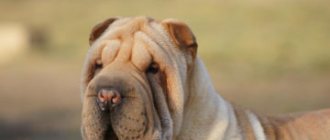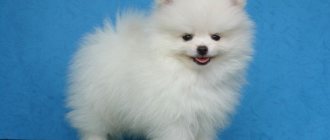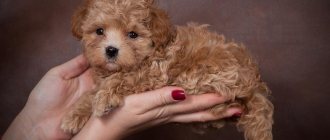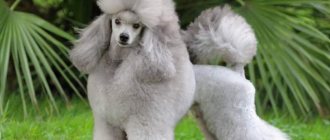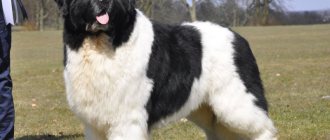The Labrador Retriever has long gained great popularity in the world. Often he is adopted into a family as a companion dog. This is not surprising, because animals belonging to this breed:
- very friendly;
- excellent with children;
- understand their owners;
- love spending time with them.
The Labrador's character is very lively and cheerful. More than anything else, he loves to walk. For this reason, the owner will have to come to terms with the need to spend at least 2 hours a day on this. At the same time, walks will be quite active - Labradors love to chase a ball or stick, dive headlong into snowdrifts and fallen leaves, and run through puddles.
However, the process of buying a Labrador puppy is quite a responsible one and in this case you should not rush at all. After all, not everyone is able to determine breed by eye.
At the same time, few people can, after just examining the appearance, confidently declare that the proposed animal is without defects. This requires experience and certain knowledge.
Breed characteristics and external data
Labrador is one of the most popular pet breeds. They are distinguished from other animals by their wonderful character. “Labrick” will be a wonderful companion; he willingly adapts to his owner and loves children. Kids of the Labrador Retriever breed are not prone to aggression, they are caring and affectionate. In addition to the initial hunting role, your new friend can serve:
- companion;
- guide;
- lifeguard;
- bloodhound.
A purebred dog can boast of a good appearance. The dog is strongly built, with strong bones. Acceptable height at the withers is 54-57 cm. It has a wide skull, chest, and loin. The dog's front paws are clawed and straight, the toes are arched, with well-developed pads. The coat is short and thick, repels water. The muzzle is massive, wide, with well-developed nostrils. A distinctive feature of the breed is its not very long, thick tail, gradually tapering towards the base, without bending behind the back.
What colors are there?
There are three main colors considered normal for this breed:
- Black - this used to be the main standard; they are distinguished by their chic shiny wool. Puppies' fur is not as bright as that of an adult dog, but this goes away with age.
- Fawn or yellow - this category includes all light shades - from almost white to red. The color is slightly uneven - the ears and back are usually darker than the rest of the body. As the dog gets older, the color may either lighten or darken.
- Chocolate (brown or liver) - acceptable colors range from reddish brown to dark chocolate. In this case, the presence of a white spot on the chest is allowed. In summer, dogs of this color are prone to fading in the sun - the color fades greatly.
Which color to choose is up to you. The main thing is to inspect the puppy before purchasing, and do not rely only on the photo. The photograph does not always accurately convey the color of the coat. It is advisable to purchase a puppy from a two-color litter (black and fawn; black and brown). Usually, quality breeders do not agree to breed to produce tricolor litters - this can lead to deterioration of pigmentation in fawn puppies.
How to choose the right puppy
Choose a Labrador Retriever responsibly, because this is a creature that you will have to take care of for at least 10-15 years. Nuances:
- Do not make this decision yourself; if you do not live alone, be sure to discuss the issue with your family. Distribute caregiving responsibilities among family members, but remember that it will be difficult for a small child to cope with a hyperactive dog.
- Make a decision - you want to have a dog or a bitch. Males for the most part are larger and stronger than females, making them much more difficult to walk with. They strive to show other dogs “who’s boss” and are already interested in the opposite sex at a young age. Girls are more affectionate, calm and become more attached to their owner. Problems with them can arise during the estrus period, which lasts 21 days twice a year.
- Think about where to choose your puppy. You should attend several large dog shows and try to contact an experienced breeder there. In such places, only promising puppies with interesting pedigrees and all the necessary documents are almost always exhibited. There you can also find titled parents for your future retriever.
- The description and cost of puppies can be found on the Internet. Each large breeder has its own website, which describes breed standards and prices. Trusted nurseries can guarantee that puppies will be fully vaccinated. Avoid flea markets where no one can provide the puppy's measurements.
Purpose of acquisition
This is a universal dog with a wide variety of working qualities. The main purposes for purchasing retrievers are for show, breeding, hunting, or just as a pet. The requirements for dogs that will perform are very strict, which will make choosing a puppy difficult. When choosing a hunter, it is important that the dog is not cowardly or timid during puppyhood. For a pet, the main requirements are health, good mental health and an affordable price.
Criterias of choice
- Breeder qualifications - choose proven ones.
- Male or female - according to qualities.
- The price of a puppy varies between 30-60 thousand rubles.
- Working qualities of parents - depending on the purpose of acquisition.
- Temperament and type - according to your preferences.
- The structure of the hairline should be thick and water-repellent.
- The physical condition of the puppy is healthy, plays, vaccinated.
- The tail should be short and thick at the base. Should not curl over the back, as in some breeds.
- Muzzle – with narrow and thick ears; pupils are colorless.
Which coat color do you prefer?
Breed standards allow three types of retriever colors: black, beige (brown) and fawn (dudley). Often future owners think that there are differences other than visual ones. The temperament, character and health of a puppy do not depend in any way on color. The psychological factor is on the side of light-colored dogs - people subconsciously treat them more calmly. Fawn Labrador puppies are widely advertised, which is the description of the dog people imagine when they hear about Labradors.
Girl or boy
Who to choose - a boy or a girl? This question is often asked by people who want to buy a dog. The difference is insignificant, but there are some nuances that require description.
The main problem that the owner of a girl may face is estrus. Its consequences can be both damaged furniture and unwanted pregnancy. But Labradors are fairly clean dogs, so there shouldn’t be any problems with dirty furniture. To avoid unwanted pregnancy, it is necessary to closely monitor the dog during heat and drive away the yard "gentlemen". In general, girls are considered easier to train and have a gentler disposition than boys.
Similar article: Standard and non-standard Labrador color varieties
The boy is slightly larger than the girl and is more difficult to train. In addition, when meeting a female dog who is currently in heat, it can be very difficult to control. However, when choosing a male, you can rest assured: no one will bring you puppies in the lap.
We recommend this article:
What is the difference between a Golden Retriever and a Labrador and which is better?
Diet of a small Labrador
A dog, if it is fed correctly, always has the same weight, looks healthy, its coat is shiny and free of dandruff. A good appetite is an indicator that the dog is being fed properly. At a young age, it is better for the pet to be rather thin in appearance than fat, so as not to interfere with the development of tendons and joints. It is better to stick to the diet that the breeder practiced, and only introduce new products over time.
Approximate daily diet for a small Labrador: meat 15 g per 1 kg of dog weight, carbohydrates - 5 g per 1 kg of weight, fats - 2 g per 2 kg of weight. Don't forget to drink - clean water should always be available. Stick to the formula above and avoid:
- fatty pork;
- sausages;
- peppery and spicy foods;
- bones (can lead to constipation);
- spoiled products;
- any sweets.
How many times should you feed your puppy?
Until two months of age, Labrador puppies eat 6 times a day. Do not feed the puppy at night; distribute these 6 feedings throughout the day approximately every 3.5-4 hours, and then, as the number of feedings decreases, increase the interval between them. From 2 to 4 months the puppy is fed 5 times a day, from 4 to 5 months - 4 times, from 5 to 6 months - 3-4 times. From 6 months, gradually transfer your Labrador puppy to the diet of an adult Labrador. From the age of 6 months, feed your Labrador twice – in the morning and in the evening, at certain hours.
What to feed with a natural diet
If you feed your Labrador with regular food, it is important to properly balance the diet. Remember: Labrador puppies are not gourmets, there is no need to try to diversify their food - it is better for the food to be the same, but always complete. Any flavoring additives (spices, ketchups, mayonnaise, etc.) are harmful and dangerous for a dog. Include in your diet:
- Meat is a large part of natural nutrition. Any part of beef is included in the diet (goulash is suitable, take tendons, veins, trachea, cheeks), lamb is recommended. Give the meat raw, fresh or after freezing. You cannot cook it for a long time if it is intended for a dog.
- Vegetables and fruits, herbs (vegetable components are given lightly stewed in a frying pan, boiled in water).
- Porridge. Keep in mind that many people love buckwheat and are allergic to it.
- Diverticular disease of the colon
- Salad with red fish: delicious recipes
- Headaches with cervical osteochondrosis
Premium ready-made food
When feeding your Labrador with ready-made food, there will be no problems with choosing a diet. The question is one thing - the food needs to be selected successfully. Buying the most expensive one will not guarantee that it will suit your dog. Buy food in small packages at first. Study how your Labrador reacts to it, whether there are any allergic reactions: check for redness in the ears, belly, and interdigital spaces. See if your Labrador eats this food with pleasure. Pay attention to dry food from the Holistic line.
Before purchasing
First, you need to decide what tasks the dog will perform and whether all family members will be happy with the dog.
If it is assumed that the pet will participate in exhibitions and win medals, then it is imperative to check in advance that he has all the necessary official documents: birth certificate, pedigree, veterinary passport. Certificates for a puppy are usually issued no earlier than on the 45th day of birth. Since during this period a mark is placed on his groin and right ear, the number of which is then transferred to all his documents. The metric must indicate the gender of the puppy, its breed, name, color and date of birth. The document is usually issued by the Russian Canine Federation. The dog's real pedigree is a laminated document issued by the Russian Canine Federation. It must have a hologram and an emblem in the form of a dog’s head with a circular inscription - RKF. It contains all the information about the puppy’s breeder and all known representatives of his ancestors.
In addition to the birth certificate and pedigree, the puppy must have an international veterinary passport, which, in addition to all the data contained in the birth certificate, contains information about all vaccinations given to it against diseases. The passport is filled out by a veterinarian. In the future, information about deworming, reproduction, microchipping and ectoparasite treatments will be entered into it.
How to arrange a place of detention
When you have a small puppy, you need to create a “place” for him where the baby can sleep. Place the “place” in a dry, not very warm room - for example, a room or a hallway, not near a central heating radiator, not near a stove, and not on the go. Excessive heat has a bad effect on the animal; it will interfere with your pet’s sleep. It is advisable not to place the puppy in the hallway or kitchen if the size of the apartment allows a different arrangement.
The “place” for the first time can be a small, not deep box (or box), with a mattress pad, which must be washed occasionally. For “space,” avoid drafts. Labrador puppies eagerly go to their place with all the toys and bones. The little Labrador sleeps a lot, so give him that part of the apartment where it is as quiet as possible most of the time.
approximate cost
How much does a Labrador puppy cost? The cost of these babies can be very different: they are sold at both quite reasonable and exorbitant prices. You can buy a baby without vaccinations, certificates and a veterinary passport for 5–15 thousand rubles. If the puppy has a passport, you can purchase it for 20–35 thousand rubles. Although with such dogs you are unlikely to win at the show.
If you purchase a Labrador for the purpose of participating in exhibitions, purchasing such a dog will cost you 40–60 thousand rubles. Such a dog, as a rule, has excellent characteristics and all the necessary documents.
Similar article: How to choose a nickname for a Labrador boy and girl
Features of education and training
As you train your dog, you will develop your own methodology. The main thing is that the classes are friendly and useful. Follow the generally accepted Labrador training tips to help train your puppy:
- Choose a site where there will be no one except you and the dog.
- Classes should be short - children are not able to concentrate for long.
- If you use a toy as a reward, use the item only for activities. Then it will be of great value to the Labrador.
- If you reward with treats, they should be in the form of small pieces that are easy to swallow.
- All “goodies” are excluded from the daily diet.
- End your classes on a happy and positive note.
Animal health
It is no secret that every future owner who is interested in how to choose the right Labrador puppy dreams of purchasing a healthy and strong dog. Like most large breeds, Labradors are susceptible to some hereditary diseases. One of them is hip dysplasia, as well as eye pathologies. The breeder's task is to control the genetic factors that are responsible for the development of these diseases.
Of great importance in this matter is the health status of the baby’s parents, which must be taken into account when assessing the requirements of the standard. Answering the question: “How to choose a Labrador puppy?”, dog experts and veterinarians recommend buying a baby only if there are x-rays of the hips - these animals can be used for breeding. It should be understood that this method has some limitations, but if your goal is to acquire a healthy baby, you must request all documents from the breeder.
Where to buy a Labrador in Moscow
It is worth paying attention to nurseries registered according to the rules of the RKF. As a rule, the older the nursery, the more guarantees it can provide. A simple search on the Internet reveals many similar companies in Moscow and St. Petersburg. The Amar Vasant kennel was registered and licensed in 1998, provides free consultations on the selection of puppies, and a detailed description of the dogs is available. Many of the nursery's Labradors have been successfully exhibited at various competitions, including the Russian Championship.
Coat type
As already mentioned, this breed has short hair with a dense undercoat . It should be hard to the touch, dense and without bald spots. There should be no fringes or curls on it.
IMPORTANT!
The undercoat has water-repellent properties.
The undercoat is never the same color as the center coat . Its peculiarity is fat, which should be noticeable if you run your fingers over it.
Character traits
This breed is gaining popularity not only because of its attractive appearance, but also because of its wonderful character. Labradors have a strong psyche, high intelligence and friendliness, with which they are ready to envelop every creature in their path.
Animals of this breed are very affectionate, playful and active..
They love playing in the fresh air, jogging, and any physical activity, but at the same time, due to their strong attachment to their owner, they can obediently and diligently stay next to him on the street and in the apartment.
It must be remembered that despite all the obedience, Labradors are primarily still a hunting dog breed; they need physical activity.
This breed loves to chase cars, so do not let your dog off the leash near the roadway..
Expert opinion
Kozhevin Semyon Kirillovich
Expert dog handler.
“Labradors are one of the friendliest breeds. With proper upbringing, they will never offend either a child or a passerby. The dog loves to play outdoors, but will easily stay at home if the owner, for example, gets sick. The Labrador is very easy to train and raise; the animal responds to any command or request on the fly.”
Basic care rules
When caring for a Labrador , you must follow several rules:
- Monitor his body temperature (several degrees above the environment, but not less than 35 degrees).
- Monitor the puppy's weight and feeding (every hour and a half, it is best if the mother is constantly with the puppies).
- If you are underweight, you should intervene and start feeding them or check the condition of the gastrointestinal tract and start treatment in a timely manner.
- When teeth begin to erupt, give him the opportunity to chew on something.
- Monitor your puppy's stool (color, smell, consistency).
- Training (starts at 2-3 months).
- Hair care (constant combing, keeping clean).
- Timely vaccination (puppies are not protected from all diseases, so vaccination is one of the most important stages; this should be done at the age of 16 weeks).
Source
Types of crossbreeds (mestizos)
There are also types of dogs crossed with the Labrador.
The most popular mestizos are :
- Labrador and poodle mix;
- Mixed labrador and husky;
- Mixed labrador and husky;
- Mixed Labrador and Shar Pei;
- Labrador and German Shepherd mix;
- Mixed Labrador and Staffordshire Terrier.
Pet behavior
The Labrador Retriever's temperament has the following characteristics::
- This breed is distinguished by excessive intelligence and intelligence, which is what their look should indicate;
- They always try to be useful to a person, become attached, try to become a true friend for them;
- Get along equally well with adults and children;
- They have a high level of learning ability, because of this they are easy to train and amenable to education;
- They are friendly, kind and non-aggressive. Aggression is a disqualifying sign.
Can a dog change as it ages?
Like any other creature, your Labrador's behavior and appearance can change with age.
This is most evident in changes in character traits.
Aging Labradors now perceive separation differently; they become susceptible to separation from their owner and react to it especially acutely . When meeting, they can be violent, rejoicing at the return.
They also become less receptive to commands, and their activity decreases.
You can also notice changes in appearance - they look haggard, move slower than usual, the coat becomes more faded.
